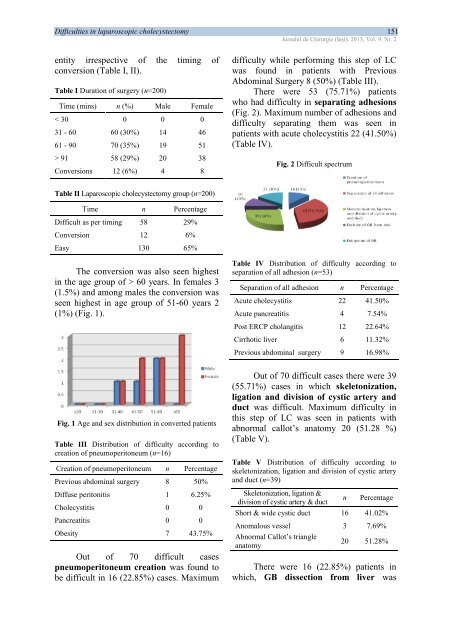PDF (5 MB) - Jurnalul de Chirurgie
PDF (5 MB) - Jurnalul de Chirurgie
PDF (5 MB) - Jurnalul de Chirurgie
Create successful ePaper yourself
Turn your PDF publications into a flip-book with our unique Google optimized e-Paper software.
Difficulties in laparoscopic cholecystectomy 151<strong>Jurnalul</strong> <strong>de</strong> <strong>Chirurgie</strong> (Iaşi), 2013, Vol. 9, Nr. 2entity irrespective of the timing ofconversion (Table I, II).Table I Duration of surgery (n=200)Time (mins) n (%) Male Female< 30 0 0 031 - 60 60 (30%) 14 4661 - 90 70 (35%) 19 51> 91 58 (29%) 20 38Conversions 12 (6%) 4 8difficulty while performing this step of LCwas found in patients with PreviousAbdominal Surgery 8 (50%) (Table III).There were 53 (75.71%) patientswho had difficulty in separating adhesions(Fig. 2). Maximum number of adhesions anddifficulty separating them was seen inpatients with acute cholecystitis 22 (41.50%)(Table IV).Fig. 2 Difficult spectrumTable II Laparoscopic cholecystectomy group (n=200)Time n PercentageDifficult as per timing 58 29%Conversion 12 6%Easy 130 65%The conversion was also seen highestin the age group of > 60 years. In females 3(1.5%) and among males the conversion wasseen highest in age group of 51-60 years 2(1%) (Fig. 1).Table IV Distribution of difficulty according toseparation of all adhesion (n=53)Separation of all adhesion n PercentageAcute cholecystitis 22 41.50%Acute pancreatitis 4 7.54%Post ERCP cholangitis 12 22.64%Cirrhotic liver 6 11.32%Previous abdominal surgery 9 16.98%Fig. 1 Age and sex distribution in converted patientsTable III Distribution of difficulty according tocreation of pneumoperitoneum (n=16)Creation of pneumoperitoneum n PercentagePrevious abdominal surgery 8 50%Diffuse peritonitis 1 6.25%Cholecystitis 0 0Pancreatitis 0 0Obesity 7 43.75%Out of 70 difficult casespneumoperitoneum creation was found tobe difficult in 16 (22.85%) cases. MaximumOut of 70 difficult cases there were 39(55.71%) cases in which skeletonization,ligation and division of cystic artery andduct was difficult. Maximum difficulty inthis step of LC was seen in patients withabnormal callot’s anatomy 20 (51.28 %)(Table V).Table V Distribution of difficulty according toskeletonization, ligation and division of cystic arteryand duct (n=39)Skeletonization, ligation &division of cystic artery & ductnPercentageShort & wi<strong>de</strong> cystic duct 16 41.02%Anomalous vessel 3 7.69%Abnormal Callot’s triangleanatomy20 51.28%There were 16 (22.85%) patients inwhich, GB dissection from liver was
















